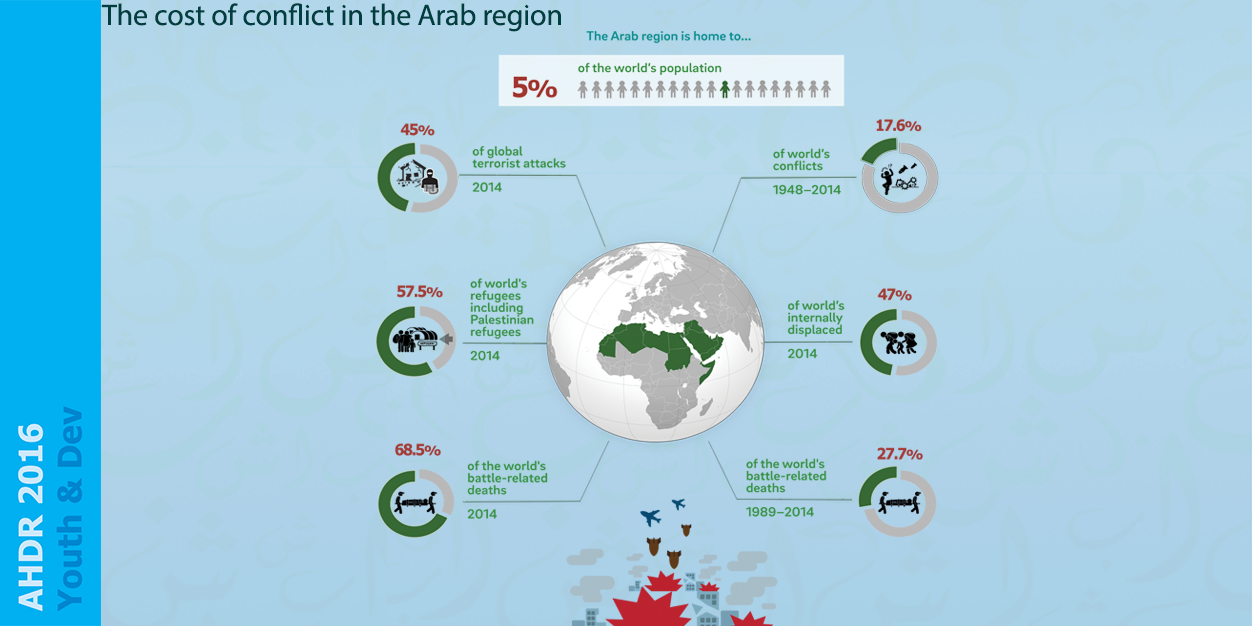
Enabling youth to shape their own future key to progress on development and stability in Arab region
Arab countries can achieve a significant leap forward in development, reinforce stability and secure such gains in a sustainable manner, if they urgently prioritize adopting policies that ensure the well-being, productivity, self-determination and good citizenship of their young population, concludes the Arab Human Development Report (AHDR) 2016: Youth and the Prospects for Human Development in a Changing Reality that the United Nations Development Programme (UNDP) launched here today.
“The wave of uprisings that have swept across the Arab region since 2011 has shown us that we can no longer treat young people in the Arab region as passive dependents or a generation-in-waiting,” said Sophie de Caen, acting Director of the Regional Bureau for Arab States in UNDP.
“Today, youth in the region are more educated, more connected and more mobile than ever before. Arab countries can reap the huge demographic dividend that its young population represents if they invest in enhancing the capacities of their youth and enlarging opportunities available to them.”
Never before has the region had such a large share of youth; youth of ages 15–29 make up around 30 percent of the population, or some 105 million people. In a region in which 60 percent of the population have not yet reached the age of 30, the report predicts that such youthful demographic momentum will be of critical importance for at least the two coming decades.
Unfavourable development backdrop
Dwindling progress on human development: The report notes that, measured in terms of the Human Development Index (HDI), all Arab countries increased their level of achievement between 1980 and 2010, driven mostly by gains in education and health, while income fell behind in comparison, notwithstanding great variations between different Arab countries. The HDI measures human well-being capturing progress in three areas: living a long and healthy life, being educated and knowledgeable, and enjoying a decent standard of living.
However, the report also indicates that the global financial and economic crisis in 2008–2009, coupled with political instability since 2011, have had a negative impact on human development in the region. Average annual growth in the HDI dropped by more than half between 2010 and 2014 relative to the growth between 2000 and 2010.
Growing inequality: Further analysis of HDI data shows also that inequality is rising in Arab countries. The region suffers an average loss of 24.9 percent when the HDI is adjusted for inequalities, which is above the world average loss of 22.9 percent. Inequality is widest in the education component of the inequality-adjusted HDI (about 38.0 percent).
Increasing conflict: The report warns that increasing levels of armed conflict are destroying the social fabric of the Arab region, causing massive loss of life not only among combatants, but also among civilians. Conflicts also are also reversing hard-won economic development gains by destroying productive resources, capital and labour, within a larger territory neighbouring countries where they are fought. Between 2000–2003 and 2010–2015, the number of armed conflicts and violent crises in the region have risen from 4 to 11, and many of them are becoming protracted in nature.
Home to only 5 percent of the world’s population, the Arab region has witnessed 17 percent of the world’s conflicts between 1948 and 2014, and 45 percent of the world’s terrorist attacks in 2014. In that same year, the region was home to 47 percent of the world’s internally displaced people and 57.5 percent of all world refugees including Palestinian refugees displaced by one of the longest lasting territorial occupations in modern history.
Exclusion and inequality continue to frustrate youth.
Against this backdrop, the Report documents tremendous obstacles young people across the Arab world are facing in their personal development across the broadest range of institutions, resulting in multiple forms of cultural, social, economic and political exclusion.
High unemployment: Failure to translate gains in education into decent jobs for youth in pace with population growth, not only curtails benefits of a demographic dividend but may fuel greater social and economic tensions in the region as well. In 2014, unemployment among youth in the Arab region (29.73 percent) exceeded twice the global average (13.99 percent), and according to estimates, the situation is expected to worsen in the near future. The report warns that Arab economies may not be able to generate the 60 million new jobs required, by 2020 to absorb the number of workforce entrants in order to stabilize youth unemployment.
Weak political engagement: The report underscores that over the past five years, youth have emerged as a catalysing force for change in the region. More young people have been raising their voices against their economic, social and political exclusion, and youth-led uprisings brought to the fore the urgent need for reform. However, the report notes that political participation among youth remains limited to informal channels of engagement, despite the lack of legal or institutional barriers to formal participation. Participation in public protests in the Arab region, in 2013 exceeded 18 percent, compared to 10.8 percent in middle income countries, whereas youth voting rates in the region were the lowest globally, remaining at 68.3 percent compared to 87.4 percent in middle income countries.
Pervasive discrimination against women: Echoing previous AHDRs, the report underlines how deep-seated discrimination, embedded in cultural beliefs and traditions in childrearing, education, religious structures, the media, and family relations, along with a plethora of legal obstacles, continues to prevent women from acquiring and using their capabilities to the fullest.
A significant minority: Pathways from frustration to radicalization.
The factors above combine to create an overall sense of exclusion and lack of opportunity that pervades much of the region. The lives of many young people across the region are marked by frustration, marginalization and alienation from institutions and the transitions that are necessary to begin adult life in a fulfilling manner.
Citing recent opinion research, the report asserts that the overwhelming majority of young people in the Arab region have no desire to engage in violent extremist groups or activities. They reject violence and regard extremist groups as terrorists.
However, it notes that the minority that is open to participating in violent groups that claim to struggle for change continue to be active. And, because of the increasing convergence of the pathways through which the dissatisfied can become radicalized and the radicalized can become violent, violent radicalization and violent extremism grow and are accelerating the tremendous damage they wreak in Arab countries.
What the report proposes: A new development model fit for youth.
Today’s youth in the Arab region have on their shoulders the burden to navigate for their own survival, but also, by their doings, they are charting the future for their generation as well as the coming ones, the report proclaims. Consequently, it sees the call for empowering youth not as one for providing support to the young generation, but rather a call for empowerment to rebuild Arab societies as a whole and head for a better future.
According to the report, the 2011 ‘dam breaking’ has revealed the existence of three interrelated crises in the region: of the state, of economic models, and of politics. And, while the focus on the ground is on the last, the report maintains that progress over the next 10 years will depend on moves along all three dimensions. Solutions for each of these crises are well known; the challenge is more with the process and sequence, and the role of youth in affecting change.
The AHDR 2016 calls for a new youth-oriented development model that focuses simultaneously on building young people’s capabilities and expanding opportunities available to them. The former requires reform in policies and essential services that affect young people’s education, health and their ability and readiness to earn a living.
The latter addresses larger macro-level challenges that face young people as they try to participate meaningfully in formal political spheres, voice their opinion and exercise their right to civil accountability, and as they battle unemployment, trying to find stable and decent jobs. It also addresses different forms of inequality, which may hold youth back from achieving their full potential.
The Report considers the achievement of peace and security at national and regional levels as a prerequisite for a future fit for youth, and it sees a central role for youth in peace-building efforts that is critical for establishing sustainable peace.
Source: UNDP
© 2016 United Nations Development Programme




Copyright © 2024 The Olive Tree SAL, all rights reserved. Terms of Use | Privacy Policy